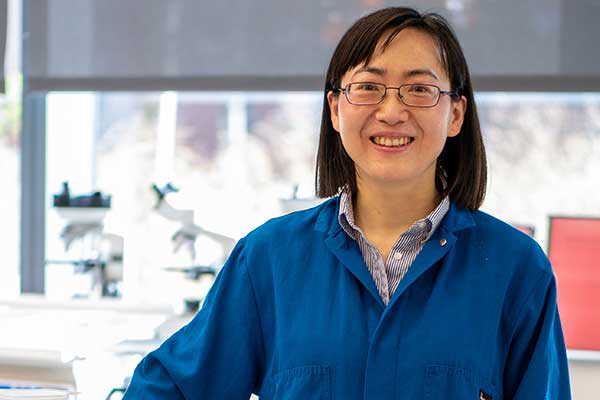Xie Awarded NIIMBL Grant for mRNA Vaccine Potency Assessment and Prediction

Wei Xie, assistant professor of mechanical and industrial engineering, has received an award with a total value of $851,000 from NIIMBL, the National Institute for Innovation in Manufacturing Biopharmaceuticals, for the project “Advanced FISH Assay and Mechanism Hybrid Surrogate to Improve mRNA Vaccine Potency Assessment and Prediction.” Project collaborators include co-PIs Sarah Rouhanifard, assistant professor of bioengineering; Paul Whitford, associate professor of physics and affiliated faculty, bioengineering; and Jared Auclair, associate teaching professor of chemistry and chemical biology, and director of the Biopharmaceutical Analysis Training Lab at Northeastern.
NIIMBL supports innovation in biopharmaceutical manufacturing technology and workforce development. This latest grant awarded to Xie is one of her three projects funded by NIIMBL, underscoring the significance of her research. Xie’s previous NIIMBL grants for induced pluripotent stem cell culture online monitoring and automation, as well as digital twin-assisted process analytical technology online training platform, have already garnered widespread industry attention on the innovative bioprocess modeling and analytical approaches created by her lab. This latest grant further solidifies Xie’s reputation as a pioneering scholar in the field of biopharmaceutical manufacturing technology.
As COVID-19 variants continue to multiply, the mRNA vaccines used to blunt the spread and severity of the virus must be altered to maintain their effectiveness against new strains. These multivalent vaccines are engineered to provide protection against several strains of the virus at once. However, quality control and quality assurance (QC/QA) of mRNA vaccines can be challenging and expensive, leading to bottlenecks in vaccine production.
To address this issue, Xie and her team are investigating assay and machine learning methods to advance the scientific understanding of mRNA vaccine delivery, transfection, and translation process mechanisms. By swiftly assessing the potency of multivalent mRNA vaccines, they aim to improve the prediction of mRNA vaccine potency and provide a quick quality screening technology. Xie’s project is an exciting development in the field of biopharmaceutical manufacturing and could help improve the effectiveness of multivalent mRNA vaccines.
Advanced fluorescence probes following single molecule mRNA
A major goal of this project is to refine the molecular-level imaging method known as single-molecule fluorescent in situ hybridization (smFISH) to make it more effective for use in the multiplexed potency assays used on multivalent vaccines. The smFISH method uses DNA oligonucleotide probes to reveal the number and position of target molecules (in this case, mRNA). It can provide time-course in vitro and in vivo measures on single-molecule RNA and co-localization of critical segments (e.g., 3’ and 5’ UTR, CDS). This enables researchers to monitor RNA integrity, track critical reaction/transport pathways, and answer important questions like “Where do RNA molecules go?” Thus, researchers can visualize mRNA as it moves across the cell membrane and through the cytoplasm to the ribosomes, organelles that will use it to produce antigens. Those antigens will in turn train the immune system to recognize and attack a virus.
The smFISH imaging technique has been in use for years, says Xie, “but using it to track the movement of individual RNA molecules within individual cells is still in development. This work can potentially make it useful in broader ways—currently, it is used in research labs, but we want to make it easier to use in large-scale manufacturing of mRNA vaccines and gene therapies.”
Among the questions Xie’s team will be examining is how the multiple, varying mRNA segments present in a multivalent vaccine will interact within a cell, and whether this affects the processes of delivery (getting the mRNA into a cell’s cytoplasm) and translation (a ribosome’s use of the mRNA to produce antigens or other proteins).
Data-Driven Bioprocess Modelling and Mechanism Learning
A second critical aspect of this project is developing a machine learning tool known as a mechanistic hybrid surrogate model. It can integrate diverse gene and protein expression measures (such as smFISH, qRT-PCR, LC-MS, and Western blots) to provide high predictive power on mRNA stability and function under different delivery conditions, enabling bioprocess risk and predictive analysis. It can advance the scientific understanding of mRNA vaccine delivery and translation process mechanisms, accounting for RNA structure-function dynamics and particle-particle interactions (e.g., RNA-RNA, RNA-protein, RNA-lipid, RNA-ion). This mechanistic hybrid surrogate will enable a better assessment of mRNA potency and identification of critical root causes of potency loss.
“Based on that understanding we can do better quality control to reduce variation and improve the potency of mRNA vaccines,” explains Xie.
Through correlating in vitro and in vivo measures, this surrogate can provide quick in vitro screening on mRNA potency, which can accelerate QC/QA procedures and enhance the consistency of mRNA quality. Xie hopes to show that by combining fluorescence optical assays with mechanistic hybrid surrogate modeling, drug developers and manufacturers can reduce their dependence on live-subject testing, which can be expensive, time-consuming, and difficult to control. She also points to the potential advantages of this innovation in a broader range of medical treatments.
“What we learn here can benefit both discovery and manufacture of mRNA vaccines and also gene therapies,” she says, referring to the practice of editing a patient’s DNA to fight or cure disease, which was leveraged to quickly develop mRNA COVID-19 vaccines. “The key idea is to support large-scale manufacturing and reduce cost. That’s a benefit to public health maybe even larger than the impact on COVID-19.”
This work is performed under a Project Award Agreement from the National Institute for Innovation in Manufacturing Biopharmaceuticals (NIIMBL).